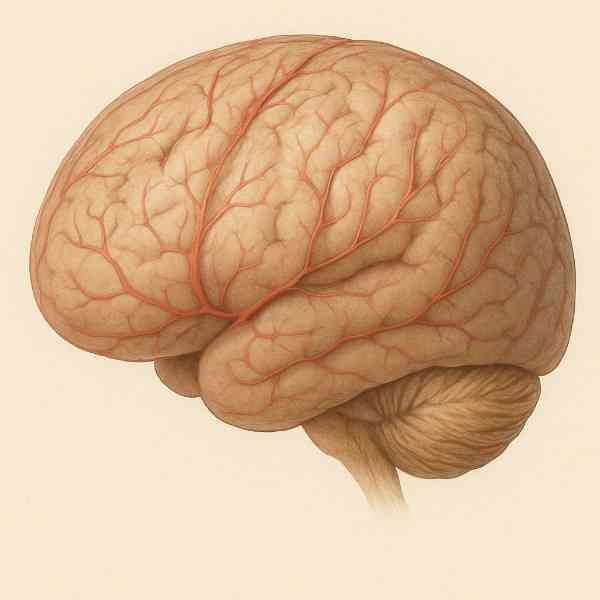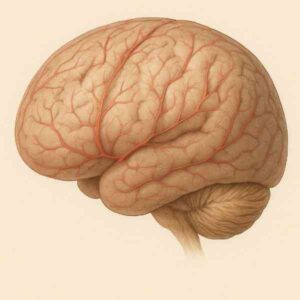The pia mater is the brain’s most faithful companion. While the dura is its armour and the arachnoid its veil, the pia is its skin – soft, invisible, inseparable. It clings to every fold and groove, following each sulcus and fissure with devotion. You cannot peel it away without peeling away the brain itself. In anatomy class we were told its name is derived from the Latin pia mater, meaning ‘tender mother’. And once you see it, you understand why.
Unlike the dura and arachnoid, the pia is hard to point to on scans or even in the operating theatre. It is so thin it is almost an idea rather than a structure. It is a suggestion of a boundary, a shimmer on the brain’s surface. Yet it is everywhere, sheltering the cortex, wrapping the cerebellum, cloaking the spinal cord. If the brain is a holy manuscript, the pia is the delicate parchment it is written on.
I was reminded of its quiet loyalty in the case of a young man who came in after a road accident. He had a contusion on his frontal lobe. The brain had slammed against the inside of the skull. On opening the dura, I saw the pia stretched tight over bruised, swollen cortex. It looked like cling film pulled over ripe fruit, translucent yet unyielding, trying its best to hold everything together. When the brain is injured, the pia does not abandon it. It holds on, even when blood seeps beneath it, even when swelling strains it to transparency.
Operating near the pia requires respect. Under the microscope, you see its tiny vessels – capillaries, arterioles, veins – feeding the neurons below. To cut recklessly is to starve a patch of brain of oxygen and thought. The pia reminds the surgeon of restraint. Lift it gently, and it yields; tug at it, and it bleeds in protest. I sometimes think of it as the grandmother in a large family: quiet, easily overlooked, but the one keeping everyone nourished with an unseen hand.
The pia has its share of drama too. Meningitis – that feared inflammation of the meninges – is in truth often pia-arachnoiditis, the tender mother and her gossamer veil both inflamed, angry, and swollen. Subarachnoid haemorrhage eventually irritates the pia as well, coating it in blood and leaving patients with spasms and fevers. And when tumours grow on the surface of the brain, the pia decides the terms of engagement, sometimes letting the surgeon peel the tumour off easily like segments of an orange, while sometimes holding on so tightly that the surgeon must shave tumour from cortex one millimetre at a time.
Patients, of course, never hear about the pia. They ask about tumours and clots, about memory and movement. But I often think the pia deserves its own chapter in the story. It is the silent witness to every thought, every dream, every seizure, every surgery. It is the first to be touched by blood, by infection, by tumour. And yet, because it has no voice, we forget it is there.
An elderly woman I operated on for a convexity meningioma asked me afterward if I had touched her brain. “Gently,” I said. “But before that, I touched its mother.” She looked confused, then amused. “So now two mothers worry about me,” she replied.
The pia does not offer easy metaphors of protection like the dura, or of delicacy like the arachnoid. Its poetry lies in intimacy. It is the line between thought and the world, between the mind’s pulsing substance and everything that tries to disturb it. You could call it fragile, but I think tender is more accurate. Fragile things break. Tender things endure.
For surgeons, the pia is both a limit and a lesson. It says, “Go this far, no further.” It asks you to tread softly at the border of consciousness. It teaches you that sometimes the strongest bonds are the least visible.
In the hierarchy of coverings, the pia may be the thinnest, but like so many thin things in life – patience, humour, skin – it’s what holds everything together. And unlike most mothers, the pia will never nag you, although it does bleed when you test its limits.





15 thoughts on “The pia mater”
Dr Mazda this was the best article for me from all your articles that I have read. Beautiful description. I loved the phrase fragile breaks but tender endures and the thin things like patience…. Etc and also that the strongest bonds are the least visible.
Beautiful
In spite of being in medical practice for 45 years, attending many neurosurgical procedures, I have never heard anybody talking so much details and functions and importance of PIA mater. Thanks , Mazda, for enlightening knowlege on the auspicious occasion of DIWALI
Very nicely written and explained sir. Loved the grandmother part. Amazing piece to read. ❤️
Tugged at my heartstrings…being a grand mother. Thank you for this tender and brilliant piece.
Mazda, ‘mother, grandmother, tender, endure, ‘ such heart warming words to describe the Pia of the brain. Shows your passion and love in the work you do to help patients survive with your excellent skill and talent.
Thankgod for doctors like you.
Bless you.
Thanks once again for guidance either on Brain or Spin its always a wonderful hinting what is right for us.
What a beautiful piece, Mazda. Poetic, profound, and deeply human.
The way you describe the Pia feels almost spiritual. A reminder that the strongest bonds in life are often the softest ones.
Superb ,the way you choose and hold words so appropriate to the subject 😀 Each write up is unique 👌
I agree with Jagruti, this one is one of the very best you have written.
You’re an amazing surgeon but to turn your hand to an expression of the unspoken thought is incredible.
So grateful to bear witness to your genius!
Wonderful article .
That’s a beautiful article. We never hear about the pia mater in the discussions on clinical neurology and neurosurgery, for us who don’t directly deal with the brain.
You have a gift in writing, Dr. Turel.
Thank you for this.
Dr. Nicely described and explained.
Dearest Dr Mazda sir
What an incredible Article full of Technical Medical terminology explaining the PIA so well like a Professor in Medical college ….
As told many times before , over & above super fingers in surgery your Fingers do magic in your awesome pieces too …..
Keep on enlightening your Readers with your outstanding medical vocabulary with Touch of humor….
God bless you sir on this Auspicious Occasion of Diwali festival 🌹
I agree, a separate chapter is now needed about pia after its description by Dr Mazda.
Beautiful description of the pia.we as lay people never heard of this part of the brain.Reading about it’s role sure we can see it’s humble and caring nature. Thanks for educating us and entertaining us at the same time.Happy Diwali to u and ur near and dear ones.